
Atlas F1 Senior Writer
In January 2003, at the Detroit Auto Show, Ferrari president Luca di Montezemolo announced that Ferrari would go public with an offering of its shares sometime in 2003. In a three-part series of articles, Atlas F1's Senior Writer and in-house Counsel, Thomas O'Keefe, takes us inside the Board Rooms of Fiat, Ferrari and General Motors to see what is holding up the Ferrari IPO and why you might be deferring that 'Buy 100 shares of Ferrari' call to your broker for just a bit longer
What if you had a parent that was good to you and nurtured you well throughout your childhood and adolescence, but had somehow in later years became a profligate wastrel with his own money and now with yours?
What if you were financially successful and had done all you could to subsidize your parent's extravagant ways but had now had enough with quietly going along with what you knew were bad spending habits that eventually were going to bring you down along with the parent as surely as the sun comes up in the morning?
What if you had big plans for yourself about how to expand and grow and improve your lot in life but just knew that if you stayed at home and continued to live under your parent's roof, your dreams would die as the house collapsed around you?
What then? How would you go about coming out from under the shadow of your parent?
As a consequence of its cash-strapped position, Fiat finds itself at the mercy of its lenders, its unions, the Italian Government and a weak worldwide economic climate that has forced Fiat to engage in rigorous cost-cutting programs and to sell off and divest itself of some of its non-core assets, including profitable ones. Why? To achieve the Holy Grail of "debt reduction", which has been required by Fiat's lenders as a condition of continuing to make credit available to Fiat while it sorts out its economic problems.
What is a rich child like Ferrari to do to help get its impoverished parent Fiat out of its dire fiscal straits? Ferrari's President, Luca di Montezemolo - a lawyer by training, a racer by instinct, and an elegant salesman by experience - has the answer. Spin yourself off from the parent and take yourself public by means of an Initial Public Offering ("IPO") of stock by Ferrari to members of the public and the investment community who might want to become shareholders in Ferrari.
The stock symbol on the New York Stock Exchange for Fiat S.p.A. American Depository Receipts is, ironically, "FIA" and there is a company called "Ferraris Group PLC" that is already listed on the Over The Counter market, so in order to sell stocks in Ferrari separately in the United States a new stock trading symbol would have to be applied by Fiat for Ferrari to display on the ticker tape and in the financial pages of the newspapers: "TFSI" is the obvious candidate for the Tifosi IPO.
He is the Marquis of Maranello, the original Man Who Has It All: talent, good looks, charisma, a happy family life, fabulous mentors, a genius for being in the right place at the right time, a varied and interesting career in business and sports, and the political and managerial skills to run the Empire of Passion that is Ferrari. And he still lives in the city where he was born 56 years ago - Bologna, Italy - these days in a hilltop 19th century villa reached by a winding road dotted with cypress trees, a great commute in one of his Maseratis or Ferraris. In his youth, he trained at La Sapienza University in Rome as a lawyer and studied International Affairs and Commercial Law at Columbia University in New York City in 1973.
Before he went to New York, di Montezemolo was an amateur rally driver for Lancia and appeared as a guest on a famous Rome talk radio phone-in show of the time, "Call Rome 3131". Listening to the talk show that day in his office at the farmhouse now called No. 27 Fiorano was none other than Enzo Ferrari, and he liked the young lawyer/racer's spirited reaction to a caller's claim that motor racing was only a rich man's sport. In challenging the caller's premise, the young lawyer cited Enzo Ferrari as Exhibit A, a man of no particular means who worked himself up from mechanic to driver to race team manager for Alfa Romeo and ultimately established Ferrari.
Typically, the impulsive Enzo reached for the white phone in his office and called the radio station live to find out how to contact di Montezemolo and set up a meeting. The Commendatore and the fledgling rally driver did meet before di Montezemolo left Italy for his masters degree studies at Columbia University, and Enzo let it be known that when di Montezemolo finished his studies, Enzo would be happy to offer di Montezemolo a position as sporting manager at Ferrari. What better way to leave for a year of post-graduate work knowing you already have a job waiting for you upon your return home!
When di Montezemolo returned, he took Ferrari up on the offer. As of 1973, Fiat had just acquired shares in Ferrari after four years of strategic alliances between the auto giant of Turin and the specialty sports car manufacturer and racing team from Maranello. It is thought that the terms of the deal - worked out between Enzo Ferrari and Gianni Agnelli on June 18th 1969 - were along the following lines:
At the time the Fiat/Ferrari strategic alliance was put in place in 1969, Scuderia Ferrari was far from the dominant marque it is today. Although Ferrari was even then a force in Formula One, the Formula One team had not won a Championship since 1964, the sports car team had not won Le Mans since 1965, and the whole company was in somewhat of the doldrums. Italian favorite Lorenzo Bandini was killed in a fiery crash in his Ferrari 312 at Monaco in 1967, Ferrari had won only one Grand Prix in 1968, would win no races in 1969 and, appallingly, had finished dead last in the 1969 Constructors' Championship.
Indeed, as of that Thursday, June 18th 1969, when Messrs. Ferrari and Agnelli struck their bargain in Agnelli's offices on the eighth floor of the Corso Marconi Building in Turin, Ferrari was down to running only one car at each Grand Prix - Chris Amon in the Ferrari 312 - and he had not been doing too well. Magically, on the next Sunday at Zandvoort for the 1969 Dutch Grand Prix, Amon finished in third place, after a close battle among the Ford-engined cars that took all the other points-paying positions, the Matra MS9-Ford (Jackie Stewart), Lotus 49B-Ford (Jo Siffert), McLaren M7A-Ford (Denny Hulme) and Brabham BT26A-Ford (Jacky Ickx).
When di Montezemolo came on board in 1973, Enzo was 75 years old (he would ultimately live until the ripe old age of 90, dying in 1988), and Ferrari was still struggling after three years under Fiat's ownership. Once at Ferrari, di Montezemolo became known to the late Gianni Agnelli, also a lawyer, and the young lawyer and the older lawyer worked from that point on throughout their years together to support Fiat's effort to bring Ferrari back to the top.
When he became Assistant Team Manager of Ferrari in 1973 and later on Sporting Director, di Montezemolo was not experienced in the ways of Formula One racing but, always a good judge of people, he proved to be a quick study in dealing with the two most important players in the rescue of Ferrari at the time: Enzo Ferrari and Niki Lauda, who, though not quite 25 years old, was a contemporary of di Montezemolo, then 27 years old. Knowing as we do now Lauda's prickly personality at 54 years old, you can imagine that di Montezemolo must have been very skilled indeed to have made this owner/driver partnership work for the Scuderia.
But work it did. Lauda joined the Ferrari team along with the more experienced Clay Regazzoni, then 35, a Swiss who had previously been at Ferrari in the 1970, 1971 and 1972 seasons. Regazzoni had been with Lauda at BRM during the 1973 season where he had seen first hand the promise of the young Austrian.
Enzo Ferrari also gave his young aide di Montezemolo the job of dealing with Bernie Ecclestone on behalf of Ferrari on certain matters. As head of the Formula One Constructors' Association ("FOCA"), Bernie usually dealt with Enzo Ferrari directly and paid his respects to Mr. Ferrari by making the trip to Maranello periodically to keep Ferrari informed on what was going on. Bernie remembers Enzo as "very supportive" of what he was trying to do for FOCA. As Bernie told the Observer last year:
But Enzo could not do everything, and lesser tasks on Ferrari's behalf fell to di Montezemolo and all these years later, now that di Montezemolo is himself a force to be reckoned with in Formula One and one of the prime movers in the Grand Prix World Championship Holdings ("GPWC") entity - formed by the manufacturers threatening to develop a rival series to Formula One - di Montezemolo remembers the slights and trifles he experienced in coming into contact with Bernie, as he told the Sunday Times in December 2001:
So great were Ecclestone's merits that the teams were prepared to forget his economic greed. Other managers were happy with 10 to 20 percent but he was not. If now Ecclestone for his own reasons decides to sell the TV rights to others then he no longer has the constructors on board.
We get 43 percent of the profits - he and the FIA get 57 percent. The teams have a contract with Ecclestone until the end of 2007. It will be respected there will be no split, no alternative championship. It will be one championship where the constructors have 100 percent of the cake and will thus be self financing, including the little teams."
Di Montezemolo obviously learned much in working with Bernie, the only one of his mentors still alive. And now in the current era of Formula One, di Montezemolo has become the catalyst for bringing Ferrari to its current dominant position, having convinced Agnelli in the early 1990s that Ferrari had to marshal the resources to hire Jean Todt in 1993, Michael Schumacher in 1996, and Ross Brawn and Rory Byrne in 1997 to lead Ferrari back to greatness, a prognostication that has been so correct that the Ferrari Formula One team has now enjoyed more success under di Montezemolo than it did even under Enzo Ferrari himself.
Today, then, di Montezemolo as President and Managing Director of Ferrari is very much his own man and faces new challenges at Ferrari, this time facing them alone, without either of his famous mentors to help guide him, although you can imagine that they are still very much with him in spirit. Indeed, when di Montezemolo spoke on February 7th 2003 at the launch of the new Ferrari - dubbed the F2003-GA in honor of Gianni Agnelli - he mentioned his close relationship to Agnelli and why the car was named after him:
Indeed, at times, di Montezemolo has been at great pains to distinguish chique Ferrari from the lumbering Fiat Group:
As regards Fiat, I am confident that the Fiat Automotive problem can be solved, but it has nothing to do with Ferrari."
As for the Tifosi IPO, di Montezemolo let it be known that he favored taking Ferrari public years ago, when two contrasting and conflicting circumstances became apparent to him: first, Ferrari's eventual success in Formula One, manifest in the 1999, 2000, 2001 and 2002 World Constructors' Championships and the 2000, 2001 and 2002 Drivers' Championships; and second, Fiat Group's financial death spiral, which has ironically been unfolding during the same period that Ferrari has been prospering. Indeed, from the year 2000 to date, there has been an inevitable tension between Ferrari and Fiat as to what to do about Ferrari, the prosperous child amidst a family deeply in debt, because of the different perspectives Fiat and Ferrari have when they look at the asset we know as Scuderia Ferrari.
Then prompted by di Montezemolo's public statements urging an IPO, Fiat responded to queries from the press in December 2000 by saying that Fiat has considered floating Ferrari but so far had ruled it out. However, in May 2001, before the fallout from 9/11, certain Fiat executives were beginning to agree with di Montezemolo. And by May 2002, with two more Ferrari Championships now in hand, Fiat became more open to the idea and began to work with di Montezemolo as to plans for floating Ferrari on the stock market.
Part I: The Empire of Passion
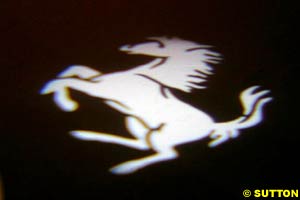 This is the situation Ferrari - the successful child of its profligate parent, Fiat S.p.A. - is in today: Ferrari is phenomenally successful as a manufacturer of sports cars, as a Formula One constructor and as a brand name known worldwide; while parent company Fiat is an industrial giant whose diversification from its core business and the crushing debt burden it has accumulated is eating the company alive.
This is the situation Ferrari - the successful child of its profligate parent, Fiat S.p.A. - is in today: Ferrari is phenomenally successful as a manufacturer of sports cars, as a Formula One constructor and as a brand name known worldwide; while parent company Fiat is an industrial giant whose diversification from its core business and the crushing debt burden it has accumulated is eating the company alive.
How bad is Fiat's financial condition? The 2002 Ferrari Maserati Group Annual Report issued in March 2003 proudly reports that 7,536 cars were sold in 2002 (4,236 Ferraris; 3,300 Maseratis), a 14% increase over the prior year that permitted Ferrari to pay a dividend of 120 million euros to its shareholder parent Fiat. By contrast, the overall Fiat Group, including Fiat Auto, reported a net loss for 2002 of 4.2 billion euros.
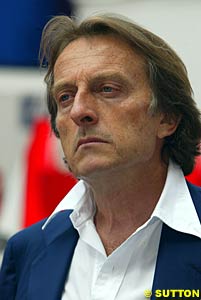 Who is Luca Cordero di Montezemolo, the man who has now come to symbolize Ferrari in the business world as Michael Schumacher has done for Ferrari in the racing world?
Who is Luca Cordero di Montezemolo, the man who has now come to symbolize Ferrari in the business world as Michael Schumacher has done for Ferrari in the racing world?
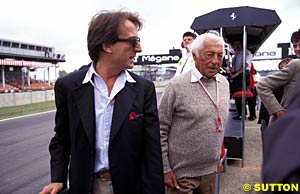 It should be remembered that at the time the old man sold part of his company to Fiat, Enzo Ferrari had been searching for a major automobile manufacturer to align his company with for years. Indeed, in May 1963, Enzo Ferrari had come very close to selling Ferrari to Ford Motor Company, calling the deal off only at the eleventh hour and after months of negotiation when it became clear to Enzo Ferrari that Ford did not intend to leave control of the racing division in the hands of Ferrari post-acquisition. That was the deal breaker for Enzo Ferrari, and for the next seven years he struggled along without a major manufacturer as a partner until he finally said "yes" to Fiat in 1969. In other words, Fiat agreed to do what Ford would not: leave Enzo in charge.
It should be remembered that at the time the old man sold part of his company to Fiat, Enzo Ferrari had been searching for a major automobile manufacturer to align his company with for years. Indeed, in May 1963, Enzo Ferrari had come very close to selling Ferrari to Ford Motor Company, calling the deal off only at the eleventh hour and after months of negotiation when it became clear to Enzo Ferrari that Ford did not intend to leave control of the racing division in the hands of Ferrari post-acquisition. That was the deal breaker for Enzo Ferrari, and for the next seven years he struggled along without a major manufacturer as a partner until he finally said "yes" to Fiat in 1969. In other words, Fiat agreed to do what Ford would not: leave Enzo in charge.
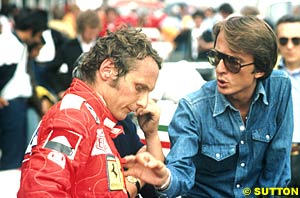 Since Regazzoni already knew the ropes at Ferrari, Lauda became di Montezemolo's special project and somehow the passionate Italian and the icy Austrian got on, both men possessed of one common trait: an iron will that drove them and ultimately the team to tremendous success. In 1974, Lauda was on pole 9 times in a 15-race season, winning at Jarama and at Zandvoort, and in 1975, Lauda brought back to Ferrari its first World Championship in 11 years, when he won 5 of the 13 races and was on pole 8 times. Mission Accomplished for both men.
Since Regazzoni already knew the ropes at Ferrari, Lauda became di Montezemolo's special project and somehow the passionate Italian and the icy Austrian got on, both men possessed of one common trait: an iron will that drove them and ultimately the team to tremendous success. In 1974, Lauda was on pole 9 times in a 15-race season, winning at Jarama and at Zandvoort, and in 1975, Lauda brought back to Ferrari its first World Championship in 11 years, when he won 5 of the 13 races and was on pole 8 times. Mission Accomplished for both men.
"I was very close to Enzo. Enzo was the sort of guy I like. You could shake hands with him. You could rely on him. You agreed on something, that was it. And he understood things. He understood that the art of negotiation is the art of the possible, not to be stupid, because you're not going to get anywhere if you are. And he did great things. His beginnings were reasonably humble and he made it. A great man. And you can go anywhere in the world and you mention Ferrari and they know what you mean."
"Bernie has many merits. From the days in Formula One when I had to go to Monza to threaten to pull out the cars if we did not have more tickets and when TV only broadcast the Grand Prix in Italy, Monte Carlo and Nurburgring we have reached the success of today.
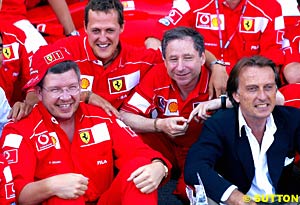 Di Montezemolo also revealed what he perceived to be Bernie's modus operandi: when Bernie wanted to develop a consensus among the teams on any issue, he first convinced Ferrari of whatever he wanted to do, and once Ferrari signed off, Bernie would go to the others and say, "See? Ferrari signed, now how about you?" There is some reason to believe that other team owners have co-opted Bernie's technique in the current environment based upon unconfirmed rumors that Ferrari has been assured of significant sums by the other teams or manufacturers to participate in and indeed lead the charge for the GPWC. On April 25th this year, the Financial Times revealed that Ferrari was promised an advanced payment of $50 million for it to sign up for the GPWC, and even arch-rival Ron Dennis did not object.
Di Montezemolo also revealed what he perceived to be Bernie's modus operandi: when Bernie wanted to develop a consensus among the teams on any issue, he first convinced Ferrari of whatever he wanted to do, and once Ferrari signed off, Bernie would go to the others and say, "See? Ferrari signed, now how about you?" There is some reason to believe that other team owners have co-opted Bernie's technique in the current environment based upon unconfirmed rumors that Ferrari has been assured of significant sums by the other teams or manufacturers to participate in and indeed lead the charge for the GPWC. On April 25th this year, the Financial Times revealed that Ferrari was promised an advanced payment of $50 million for it to sign up for the GPWC, and even arch-rival Ron Dennis did not object.
"to pay our gratitude to the man who supported us at difficult times and whom we all, and I personally, badly miss. He was a fundamental reference point for Enzo Ferrari first and then for myself. We worked a lot together in difficult conditions to reconstruct Ferrari."
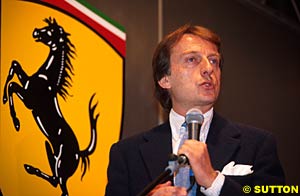 Since Enzo Ferrari was the kind of character who liked to control everything and everyone under Scuderia Ferrari's roof, the concept of taking Ferrari public and being answerable either to anonymous shareholders or grey-suited bankers would have been anathema to the Old Man. But di Montezemolo has worked within the corporate framework all his life and has been a consistent voice in favor of Fiat taking the necessary steps to "float" Ferrari, as they say in Europe, or to sell Ferrari stock in an IPO, as they say in the United States.
Since Enzo Ferrari was the kind of character who liked to control everything and everyone under Scuderia Ferrari's roof, the concept of taking Ferrari public and being answerable either to anonymous shareholders or grey-suited bankers would have been anathema to the Old Man. But di Montezemolo has worked within the corporate framework all his life and has been a consistent voice in favor of Fiat taking the necessary steps to "float" Ferrari, as they say in Europe, or to sell Ferrari stock in an IPO, as they say in the United States.
"Fiat is our shareholder. We are owned 90 percent as a financial investment by Fiat Holding Company. We are not owned by the Fiat Automotive sector. . . We are, thank God, totally independent in terms of cash flow. In F1, Philip Morris, Vodafone, shell and many others - but mainly these three - can give us the possibility to be competitive.
Next Week: Debt vs. Equity
Please Contact Us for permission to republish this or any other material from Atlas F1.
|
Volume 9, Issue 26
Atlas F1 Exclusive
Interview with Allan McNish
Giancarlo Fisichella: Through the Visor
Atlas F1 Special
Tifoso IPO
Articles
Season in the Sun: Part V
European GP Preview
European GP Preview
Europe and France Facts & Stats
Columns
The F1 Trivia Quiz
Bookworm Critique
On the Road
Elsewhere in Racing
The Weekly Grapevine
> Homepage |